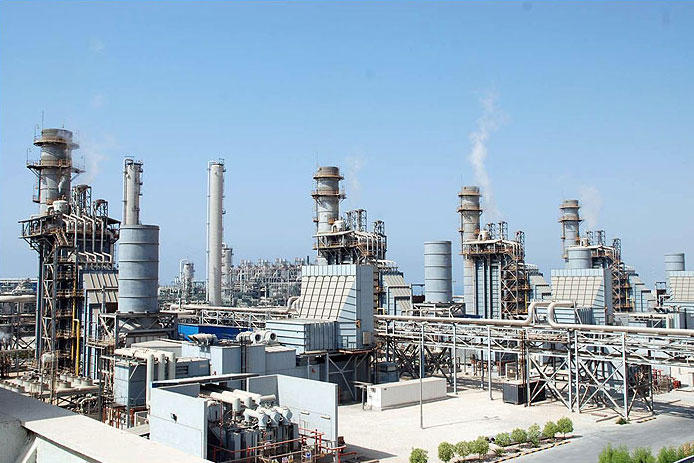Addressing the inauguration ceremony, Jahangiri highlighted the Ministry of Petroleum's success in realizing the objectives set out in the resilient economy policy instructed by Supreme Leader Ayatollah Ali Khamenei.
He said that Iran's petroleum industry showed the "best performance" with regard to the resilient economy policy in the last calendar year to March 2017.
Jahangiri said petrochemical industry is dynamic and economically justified, adding that the Ministry of Petroleum has put much effort into improving this knowledge-based industry, particularly in downstream sector.
Noting that petrochemical industry is one of Iran's priorities to attract investment, he said: "The Ministry of Petroleum has so far taken great strides with regard to attracting foreign investment, among which are the development of a new model for oil and gas contracts, signing big oil deals, attracting investment into jointly owned fields, and cooperating with foreign companies.
"The new oil contracts, whose restructuring took too much time, was welcomed by many pundits in the country. Today is the best chance for world majors to cooperate with Iran's oil and gas sector," said Jahangiri.
He said that Iran, which sits atop the world's largest hydrocarbon reserves, has to boost its position further although the Ministry of Petroleum has devised special plans for that purpose.
Jahangiri said more than $14 billion in investment had been attracted in the aftermath of the implementation of Iran's nuclear agreement with world powers, known as the Joint Comprehensive Plan of Action (JCPOA).
"Our top priority for using foreign resources is to allocate them to the private sector," he said.
"The ground is prepared for national development and we have to take advantage of this chance. We seek cooperation with the world and of course we are ready for any conditions whatsoever," he added.
Jahangiri gave a positive assessment of economic indicators in the country, saying that Iran's economic growth had reached 12% after a long period of stagnation.
Citing data from the Central Bank, he said that Iran's economy grew 6.5% in the first quarter of the current calendar year. Excluding oil, he added, the figure would be 7%.
Foreign Financing for Petchem Projects
For his part, Zangeneh said his promises had come true about the startup of a number of petrochemical projects. He said that the projects, which were launched in the last calendar year and early this year, would significantly increase Iran's petrochemical capacity.
Zangeneh named Lorestan, Urmia, Mahabad, Marvdasht, Karoun, Phase II of Takht-e Jamshid, Kurdestan, Morvarid, Phase II of Kavian, Etenkhab and Assaluyeh Takht-e Jamshid as petrochemical projects which became operational last calendar year and early this year.
In the last calendar year, three polyethylene units of the West Ethylene Pipeline with a total capacity of one million tonnes were also inaugurated.
Zangeneh said Kaveh, Phase III of Pardis and Bushehr petrochemical plants would come online this year.
He said that petrochemical projects in Iran were becoming operational at a high pace due to abundant and low-price feedstock, adding: "Most of these projects are being financed by National Development Fund of Iran (NDFI) or by other countries."
Zangeneh underscored foreign investors' strong inclination for investment in Iran's petrochemical projects, saying: "That is a very big opportunity for increasing value-added, acquiring new technologies and supplying products of higher value-added."
The minister went on to say that 2,000 ha of land had been allocated to mid-stream petrochemical industry in Assaluyeh. He said that a consultant had been chosen to give advice on necessary infrastructure.
Zangeneh said that Iran had increased petrochemical production and exports post-JCPOA, adding: "Around one million tonnes of more feedstock has been supplied to downstream petrochemical units, which means job creation, production and wealth generation for the country."
The minister said that the value of upstream petrochemical products would go beyond $40 billion in five years. He said that planning was needed in the mid-stream and downstream sectors for job creation and generation of value-added.
Polymer Output on the Rise
Marzieh Shahdaei, CEO of National Petrochemical Company, said Iran Plast was one of top polymer, plastic and rubber exhibitions in the world. She said that more than 530 companies from 23 foreign countries, 16 European and 7 Asian, and more than 600 Iranian companies attended this year's Iran Plast Exhibition which sprawled on 35,000 square meters of land.
Shahdaei said the Ministry of Petroleum and the NPC had made effective arrangements in recent years to realize the objectives of resilient economy so that Iran would become the leading supplier of raw materials for plastic industry.
"Iran is producing around 7.5 million tonnes a year of raw materials for polymer products, which is planned to reach 12 million tonnes by the end of the 6th [Five-Year] Development Plan and which would boost downstream polymer industry and diversify its products," she said.
Shahdaei said that out of 16 million tonnes of petrochemicals supplied on domestic market in the last calendar year, more than four million tonnes of polymer products was supplied to downstream industries.
She said that polyethylene and propylene are the most important polymer products which account for more than 60% of the country's consumption of polymer.
The NPC managing director added that petrochemical industry policymakers had put efforts into stabilizing the supply of petrochemical products on the mercantile exchange, developing domestic and international markets and providing new petrochemical grades.
Shahdaei said Iran Plast Exhibition was among the most significant specialized exhibitions in the region, adding: "This exhibition can put on display the potentialities and capabilities of this industry in the world and familiarize Iranian industrialists with new achievements in the world. It also provides an opportunity for displaying new achievements of plastic industry and showcasing innovations and technologies in this industry."
Courtesy of Iran Petroleum


Your Comment